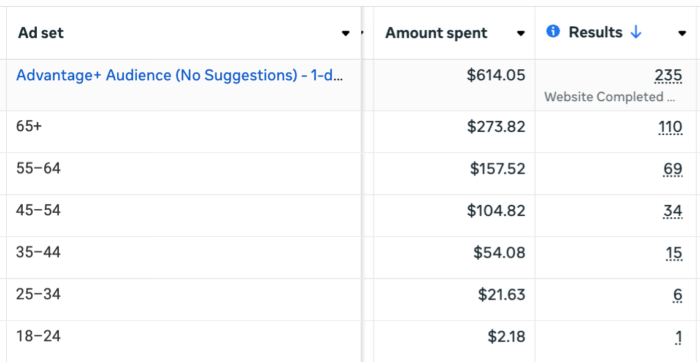This isn’t 2017. Things don’t work the way they did back then. It’s time to abandon your old targeting strategy.
It took several years of tests and curiosity to break through my stubbornness to come to this conclusion. It wasn’t easy to abandon my old ways.
Your control over targeting is different now. But even when you can apply targeting restrictions, doing so often makes your results worse.
And, of course, there are always exceptions. But it’s important that you have a clear approach and know when those exceptions should be applied.
Consider this your guide to targeting in 2025 and beyond. In this post, we’ll take a deep dive to discuss…
- The roles of detailed targeting and lookalike audiences now
- When targeting restrictions are possible and necessary
- How the performance goal impacts targeting
- Why age and gender restrictions may or may not be needed
- The fading role of remarketing
- Ad set segmentation and consolidation
Ultimately, you should see that the most effective approach to targeting these days is a simplified one. Prioritize broader targeting with fewer restrictions when possible, and know why those restrictions are necessary when they’re applied.
Let’s get to it…
Detailed Targeting
Detailed targeting is also known as targeting by interests and behaviors.

It’s important to clarify this since some advertisers confuse “detailed targeting” with any targeting inputs at all. This category of targeting does not include custom audiences, lookalike audiences, or broad demographics (like location, age, or gender).
How you approach detailed targeting may differ based on the performance goal (the action you optimize for). The reason for this is simple: The impact of your detailed targeting selection will vary.
Consider these scenarios…
When Optimizing for Conversions, Landing Page Views, or Link Clicks:

In other words, this applies when using any of the following performance goals:
- Maximize number of conversions
- Maximize value of conversions
- Maximize number of landing page views
- Maximize number of link clicks
When using any of these, your detailed targeting inputs are not respected. There are two versions of how this is communicated, but the execution is the same.
When using Advantage+ Campaign setup or manual setup with Advantage+ Audience, detailed targeting inputs are viewed as suggestions and Meta can reach people beyond these groups if it will improve performance.

If you use the old manual setup with any of these performance goals and switch to original audiences, Advantage Detailed Targeting is automatically turned on and can’t be turned off.

Your inputs are treated the same either way: As suggestions. We don’t know how much they matter or if they matter at all. But based on my tests, I’ve found little evidence that detailed targeting inputs do much of anything when used only as suggestions.
What That Means: This isn’t an endorsement of algorithmic targeting. Whether it works well or not is irrelevant in this case. You can’t avoid it.
As a result, there’s no reason to spend much time obsessing over your detailed targeting inputs when using any of these performance goals. The algorithm is going to reach whom it wants to reach to get you the most results. Any perceived difference in performance based on changes in detailed targeting inputs is more likely due to correlation than causation.
When Optimizing for Anything Else:
If you use any other performance goal, you will have the option of restricting targeting to your detailed targeting selections.
When using Advantage+ Campaign with any of the other performance goals, you have the option to use detailed targeting inputs as suggestions. It’s not required.

When using manual campaigns and original audiences with these performance goals, Advantage Detailed Targeting can be turned on or off.

What That Means: You actually have some control in these cases since you can restrict targeting to the detailed targeting inputs you provide. The bigger issue at hand is whether these performance goals will yield quality results.
In short, you should prioritize optimizing for conversions whenever possible. If you must optimize for something else and have the option of restricting your targeting to certain detailed targeting, you should consider it (assuming the audience is large enough). This may help maximize the quality of your results, though it’s a tough battle to win when focused on the top of the funnel.
The reason for this is that the algorithm only cares about getting you the result you asked for. It’s literal that way. If your performance goal is to maximize number of video views, the algorithm is not concerned about whether the people who watch your video do anything else.
Still, if you must take this approach, setting guardrails of any kind may be necessary.
Lookalike Audiences
Facebook introduced lookalike audiences in 2013. Back then, they made a whole lot of sense. One of advertisers’ vital roles was to define the audience of people who would see our ads. Lookalike audiences allowed us to provide a source audience (like our customer list) and Facebook would find other similar people.
This was a great way to expand a potentially relevant audience without relying on the guesswork of picking the right combination of detailed targeting. It’s questionable whether this is necessary now, of course. But the impact of lookalike audiences, as with detailed targeting, is limited based on the performance goal.
When Optimizing for Conversions:
If you select a performance goal that maximizes the number or value of conversions, any lookalike audience you provide is expanded.
When using Advantage+ Campaign or manual campaigns with Advantage+ Audience, any lookalike audiences are viewed as suggestions.

When using the old manual campaigns and original audiences with these performance goals, Advantage Lookalike will automatically be turned on and can’t be turned off.

What That Means: Once again, your inputs likely mean very little when optimizing for conversions. The algorithm is going to reach the people it wants to reach to get you the most results, so don’t obsess over the lookalike audiences you select in these cases — assuming you select any at all.
When Optimizing for Anything Else:
If you use any performance goal other than maximizing the number or value of conversions, you will have the option of restricting targeting to a lookalike audience.
When using Advantage+ Campaign, you will have the option of turning off suggestions related to your lookalike audience.

If you’re using manual campaigns and original audiences with these performance goals, you will have the option of turning Advantage Lookalike on or off.

What That Means: To reiterate, you should prioritize optimizing for conversions whenever possible. When you do, there’s very little reason to obsess over detailed targeting or lookalike audiences since they’ll only be used as suggestions.
That said, there are more situations when you can restrict targeting to lookalike audiences than to detailed targeting. And if you aren’t optimizing for conversions, lookalike audiences are a nice middle ground of broad audiences and restricted targeting.
Even so, I would argue that the concept of lookalike audiences is outdated now. The entire point of Advantage+ Audience and algorithmic targeting is similar to the original goal of lookalike audiences. Meta knows who has engaged with you and performed certain actions in the past, and the algorithm will find more people like that.
Because of this, I have doubts that restricting targeting to a lookalike audience provides much necessary control over using Advantage+ Audience and algorithmic targeting. Feel free to experiment, but prioritize algorithmic targeting unless you’ve found a clear need to do otherwise.
Age and Gender
Your control over age and gender selections depends on whether or not you use Advantage+ Audience. And even then, whether you control these things should be dependent on what you’re trying to accomplish.
Let me explain…
Advantage+ Audience
When using manual campaigns with Advantage+ Audience, age and gender selections are used very loosely.
You can set audience control using an age minimum that is no higher than 25.

Otherwise, age ranges and gender are considered audience suggestions.

Manual or Original Audiences
If you turn Advantage+ Audience off while using Advantage+ Campaign or use the manual campaign setup and switch to original audiences, you can use age range and gender as targeting constraints.
This allows you to turn off suggestions to set a strict age range that will be respected.

Or you could do the same with gender.

The question, of course, is whether you should restrict targeting by age or gender. Your approach should vary, based on the optimization. But not for the same reasons as we saw with detailed targeting and lookalike audiences. In those cases, your ability to restrict targeting was controlled by the performance goal.
In the case of age and gender, the performance goal has no impact on whether you can restrict targeting. The question then becomes whether you should.
The answer is found by understanding how the algorithm works, including its strengths and weaknesses. Meta’s goal is to get as many of your goal actions as possible within your budget. In some cases, that may not require any restrictions. In others, it may be necessary. And in others, it depends.
When Optimizing for Purchases:
Let’s consider a situation where your performance goal is to maximize the number or value of conversions where the goal conversion event is a purchase…

The algorithm’s focus is on getting you as many purchases as possible within your budget. A “Result” is not recorded unless you get a purchase. Therefore, there’s no value in wasting clicks on people if a purchase is unlikely.
I understand the inclination to define your ideal customer by age and gender. Maybe your target customer is a woman between the ages of 30 and 45. But that probably doesn’t mean that you need to restrict by those settings.
If men don’t buy, the algorithm should figure that out. I’ve seen examples of this in the wild. Even without restrictions by gender, the algorithm spent 99% of an advertiser’s budget on women for a female-focused product. If men can make the purchase (especially for their significant other), let them.
The same goes for people outside of your desired age range. Restricting your audience by age and gender will likely drive up your costs while preventing the possibility of getting purchases outside of that group.
One exception might be if you are unable to serve people by age group or gender. Your product is not available to people under the age of 50, for example.
But otherwise, I’d prioritize limiting unnecessary restrictions and allowing the algorithm to sort it out. It wants you to get purchases, so give it the room to find them.
When Optimizing for Leads:
This one is a bit more complicated.

Whereas the quality of a purchase is unlikely to be impacted by age and gender (if you care about the value of the purchase, optimize for value), the quality of a lead might be.
I ran into this exact situation when I wasn’t restricting age and getting a very low cost per lead. After digging further, I found that a very high percentage of my budget was being spent on people over the age of 65.

Why? Because, for whatever reason, the algorithm found a weakness to exploit in that age group. The problem was that these were low-quality leads.
But don’t assume that you’ll run into this problem, too. I’ve seen many examples where advertisers haven’t restricted their audience by age when optimizing for some kind of lead, and they did not run into this issue.
Your priority should be to limit these restrictions. Let the algorithm find you leads as efficiently as possible. If you’re getting low-quality leads because of a weakness found in a certain age group, only then should you consider restricting it.
When Optimizing for Anything Else:
Allow me to repeat myself: Prioritize optimizing for some kind of conversion whenever possible. But if there’s a reason you must optimize for something else, you should strongly consider greater targeting control.
Since the algorithm is literal, it does not care about the quality of your link clicks, landing page views, video views, or other top-of-funnel actions. And if your product primarily caters to women, the algorithm is very likely to go astray if you allow it to reach men in this case.
Why? Because your goal action is something very surface level. If you want a click or video view or post engagement of some kind, men will gladly provide that action when a conversion isn’t required. And the algorithm will think that you want that action, too.
The same is true of age ranges. You may end up getting plenty of irrelevant engagement, but the algorithm doesn’t care if these people end up buying from you. You, of course, care.
So if you optimize for any non-conversion (and you know I’d prefer you don’t), age and gender restrictions may be necessary. Let results be your guide.
A Note on Value Rules
There is actually another option when optimizing for conversions, regardless of the type (purchase, lead, or something else). Meta introduced Value Rules, which allow you to increase or decrease your bid by demographic group (age range, gender, or location).

This is specifically for situations where you have lifetime value information that Meta does not. An example may be that even though men over 65 purchase your product, women between 35 and 44 have a higher lifetime value because they come back and purchase again. As a result, you may want to either lower the bid on men or raise the bid on women in that age group.
Value Rules aren’t currently available for the Leads objective, but I assume it will be at some point. If not, you can apply Value Rules to other non-purchase events when using the Purchase objective.
Remarketing
There was a time, years ago, when remarketing made up a very high percentage of my advertising. That’s no longer the case.
This isn’t because remarketing (the process of defining our target audience using custom audiences that reflect people who are closest to us) isn’t effective. The issues with it are mostly unique to how things work today.
First, remarketing happens automatically now. You could rely entirely on algorithmic targeting, and Meta will prioritize people based on pixel activity, conversion data, and prior engagement with your ads. You can prove that this happens with Sales campaigns using Audience Segments.

Second, there’s the question of whether remarketing is a good long-term strategy because it lacks incrementality. If you focus only on those people who visit your website and are on your email list and get a high conversion rate, the question will always be how impactful your ads actually were. Would they have converted anyway if your ad didn’t exist?
I wouldn’t recommend completely abandoning remarketing in all situations, though some would suggest exactly that. Some advertisers go so far as to always exclude all remarketing audiences to focus only on new customers.
I do think there’s a place for remarketing, but it’s the exception that takes up a small percentage of your budget when it’s used.
Ad Set Segmentation vs. Consolidation
If you’re following along, you may spot a trend:
1. Don’t obsess over detailed targeting. In some cases, these inputs may not do anything at all.
2. Don’t obsess over lookalike audiences. They’re outdated, even when you can restrict targeting to these groups.
3. Limit restrictions based on age and gender, especially when optimizing for purchases.
4. Remarketing should be the exception, rather than the rule of your advertising strategy.
When you combine all of these recommendations, you’re limiting your targeting inputs. If you’re optimizing for conversions (and especially purchases), there are rarely reasons you should touch any of these things. Let the algorithm sort it out.
And if that’s the case, there’s no reason to create separate ad sets for different targeting strategies. That’s a major departure from how things worked in the past.
I know that I’m not alone in this. I’d create separate ad sets for detailed targeting, lookalikes, and remarketing. I might even create separate ad sets for groups of interests or lookalike audiences. The result was several ad sets per campaign dedicated entirely to targeting segmentation.
The result of this was we watered down our budget.
Letting go of targeting control is actually a huge advantage when you can do it. Not only does it give you less to think about, but it means consolidating your budget into, in many cases, a single ad set.
That means more data for Meta. More conversions for a single ad set. A much higher chance of exiting the learning phase and getting optimal, predictable results.
It also creates fewer opportunities for audience fragmentation and auction overlap. Creating fewer ad sets for targeting segmentation is much more efficient than the alternative.
Simplify When Possible
When it comes to targeting, throw out the rules that you may have learned five or 10 years ago. Few are relevant today.
It doesn’t matter whether you believe in algorithmic targeting. It cannot be avoided in most cases, particularly when optimizing for conversions. Many of your attempted restrictions are pointless and counterproductive.
I strongly recommend a simplified approach to Meta advertising. Prioritize limiting the number of campaigns and ad sets. Limit unnecessary customizations to settings like targeting.
Understand the way that things work now. Know that algorithmic targeting is vastly improved these days, particularly when optimizing for conversions. Remarketing happens naturally and the algorithm will prioritize many of the people you’d otherwise try to target.
There are, of course, exceptions when more complexity is needed. But don’t start with that complexity because you assume that you need it or you’ve always done it that way.
Start simple and only add restrictions to targeting because a specific problem — something that is proven based on results and how the algorithm works — needs to be solved.
Resources
I’ve produced several pieces of content (blog posts, videos, and podcast episodes) that can help you on this topic.
Your Turn
How do you approach targeting these days? Anything you’d add?
Let me know in the comments below!
















